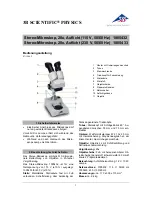
CONFOCOR
3
Carl Zeiss
Introduction to Laser Scanning Microscopy and Fluorescence ...
ConfoCor 3
6 M60-1-0025
e
02/2010
9.1.3
Performance Features of the ConfoCor 3 and the LSM 710 and LSM 780 Systems
9.1.3.1
Optical and Mechanical Aspects
The highly integrated system design makes for the shortest possible optical paths, top-grade optical
precision and high stability. The compact scanning module can be fitted to an inverted microscope in less
than three minutes. The ConfoCor 3 can only be mounted in combination with the LSM 710 / LSM 780
scanning module to the side port of the Axio Observer.Z1 microscope stand.
The spectral range available extends from the UV to the IR region.
For the VIS (visible-light) Laser Module, the user can select from up to six lasers with wavelengths of 633,
594, 561, 543, 514, 488, 477, 458 and 405 nm. The UV Laser Module provides wavelengths of 351 and
364 nm. A Ti:Sa Laser provides pulsed laser light from 680 to 1080 nm for Multiphoton imaging (NLO).
Coupling of the laser light is through polarization-preserving single-mode optical fibers. One variable
beam collimator each for the UV or NLO and visible ranges provides optimum adaptation of the
respective laser wavelength to the objective used and, thus, optimum correction for Z aberrations.
Acousto-optical tunable filters (AOTF) adjust the necessary brightness for up to 8 laser lines within
microseconds.
A monitor diode permanently registers the laser output; it can be used for the on-line checking of the
intensity of the exciting light. This check is also possible selectively for the different wavelengths if a line
selection filter is inserted.
The three internal image acquisition channels, usable for reflection or fluorescence, and an additional
transmitted-light channel are ideal for the investigation of multiple fluorescence specimens. The
ConfoCor 3 is attached to the fourth channel. The ConfoCor 3 comes with two detector types:
Gallenium Arsenide Phosphide detectors (GaAsP) or avalanche photodiodes (APD). The APDs will deliver a
TTL pulse, the GaAsP detectors deliver TTL pulse, NIM pulse and an analogue signal. Separately in each of
the four channels, the diameters of the pinholes and their XY positions can be optimized, and the desired
emission filter placed into the beam path, by servo-motor control. In the case of pinhole VP1, this
adjustment also includes positioning along Z. In the simultaneous registration of multiple fluorescence,
identical optical sections can be obtained in each confocal channel. This is of importance, e.g., with the
FISH method (fluorescence in-situ hybridization) used for genome analysis in cytogenetic studies.
The microscope's transmitted-light channel is equipped with a photomultiplier, too. It is therefore
possible to superimpose a multiple fluorescence image on a brightfield, differential interference or phase
image.
A fiber-optic cable connection to external special detectors, such as cooled PMTs or spectrometers, is not
available if the ConfoCor 3 is attached.
In addition to the emission filters for all standard and special applications, available in motor-controlled
filter wheels, the user can easily install his own emission filters in two of the channels. In the ConfoCor 3
all filter wheels can be exchanged by push and click.
The high-NA C-APOCHROMAT objectives specially developed for the LSM technique reach the physical
limit in resolving power, and can be used throughout the 380...900 nm spectral range with the same
high quality, producing brilliant images. Note, for fluorescence correlation spectroscopy the C-
APOCHROMAT objectives are highly recommended.
A two-mirror scanner system, controlled by a real time electronics, offers several advantages. The large
deflection angle of the scanning mirrors allows a wide area to be scanned. With a 1.25
×
objective, the
object area scanned is 10
×
10 mm². The scanning field size can be freely selected between 4
×
1 and
2048
×
2048 pixels.
It is possible to rotate the XY scanning field through 360° and carry out XY scans without having to
rotate the specimen itself under laser radiation load.













































